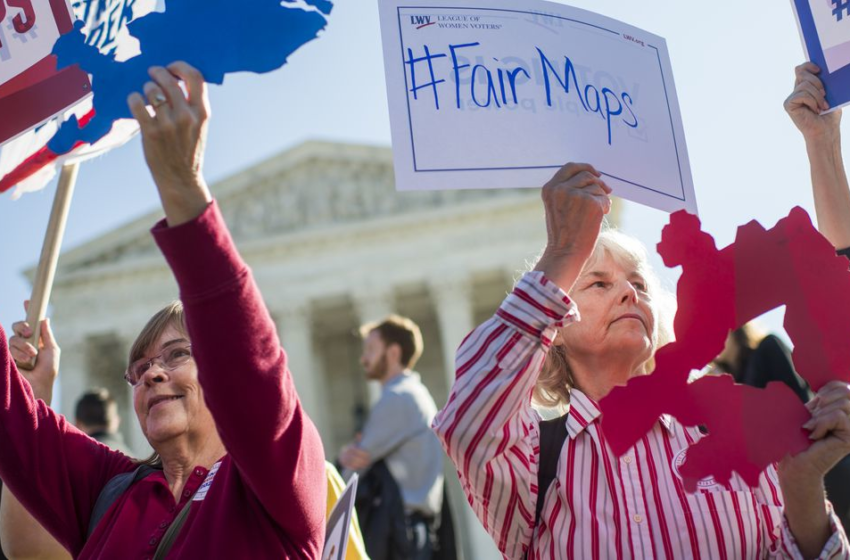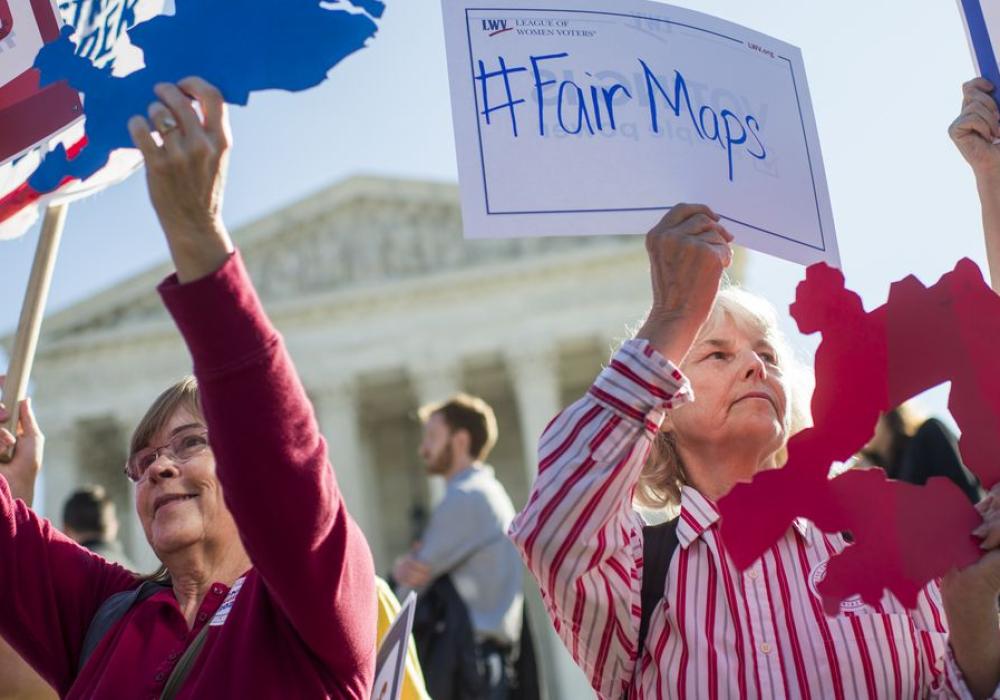On Monday, the Justice Department filed a federal lawsuit alleging that Texas’s new state house and congressional district maps violate the Voting Rights Act, which forbids gerrymanders that have the purpose or effect of abridging “the right to vote on account of race, color, or language minority status.”
The Justice Department’s complaint in United States v. Texas is a fine, workmanlike legal document that makes a strong case that Texas drew its maps in order to maximize white power within the state and minimize the impact of Black and Latino voters. It’s the sort of lawsuit that would have a good shot at prevailing — if the Supreme Court hadn’t spent the past decade dismantling nearly all of the Voting Rights Act.
As the complaint notes, between the 2010 and 2020 censuses, “Texas grew by nearly 4 million residents, and the minority population represents 95% of that growth.” Because of this population growth, Texas’s US House delegation expanded from 36 seats to 38 seats in the decennial redistricting process. Yet Texas drew its new maps so that both of the new districts will have white majorities, and it also allegedly redrew a third district to prevent Latinos from electing their preferred candidate.
The result is that white voters will gain the ability to elect two additional congressional representatives, even though Texas owes its two new seats almost entirely to Black, Asian, and Latino voters.
The Justice Department also alleges that both the new congressional maps and the new state house maps drastically underrepresent voters of color. If Latinos controlled seats proportional to their population, the complaint claims, they would control “11 Congressional seats and 45 Texas House seats.” Black voters, meanwhile, would control “5 Congressional seats and 20 Texas House seats.”
Instead, under the new maps, “Latino voters have the opportunity to elect their preferred candidates in 7 Congressional seats and 29 Texas House seats,” and “Black voters have the opportunity to elect their preferred candidates in roughly 3 Congressional seats and 13 Texas House seats.” (There is one additional congressional seat and five additional state house seats that might elect candidates preferred by a coalition of Black, Latino, and other nonwhite voters.)
Yet it’s uncertain whether the Justice Department is capable of prevailing in this lawsuit, no matter what evidence it presents at trial. That’s how hostile the Supreme Court’s Republican appointees are toward the Voting Rights Act.
As Justice Elena Kagan wrote in her dissenting opinion in Brnovich v. DNC (2021), the Court “has treated no statute worse” than the Voting Rights Act. The Court has also shielded states from federal lawsuits alleging partisan gerrymandering — a decision that potentially gives Texas a powerful weapon it can use against the Justice Department’s allegation that its new maps are an unlawful racial gerrymander.
The Supreme Court has made it nearly impossible to prove that maps were enacted with racist intent
In Rucho v. Common Cause (2019), the Supreme Court held that federal courts may not hear lawsuits alleging that a state’s legislative maps are an unconstitutional partisan gerrymander — meaning that the lines were drawn to benefit one party at the expense of another. The Court’s precedents, however, do permit lawsuits challenging racial gerrymanders — meaning that the lines were drawn to diminish the power of one or more racial groups.
In practice, however, Rucho creates a potentially serious problem for anyone alleging racial gerrymandering.
Recall that the Voting Rights Act prohibits election laws enacted for the purpose of limiting a racial group’s voting power, or that have the effect of doing so. Suppose that the Justice Department leans into the first of these two prongs: the prohibition on laws that are enacted with racist intent.
In that case, Texas is likely to argue, as it has in previous cases accusing it of racial gerrymandering, that its new maps weren’t drawn in order to reduce the power of Black and Latino voters. It will most likely argue that the maps were drawn for the purpose of reducing the power of Democratic voters.
Such an argument might even be superficially plausible. As the Justice Department argues in its complaint, “voting in Texas continues to be racially polarized throughout much of the State” — meaning that white voters tend to vote for Republicans and Black and Latino voters tend to vote for Democrats. So it’s fairly difficult to prove conclusively that the new maps were drawn with racist intent. A set of maps drawn to maximize the power of white Texans, and a set of maps drawn to maximize the power of Texas Republicans, are likely to closely resemble each other because race is a good proxy for partisan affiliation in Texas — as it is in much of the United States.
Of course, this argument that partisan gerrymandering is distinct from racial gerrymandering could fail — and, in a fair court, it probably would fail. If state lawmakers intentionally minimized the influence of Black and Latino voters because they knew those voters were likely to be Democrats, that’s still intentional race discrimination.
But if the Justice Department wants to show that Texas’s new maps were drawn with invidious racial intent, it still must overcome another of the Court’s decisions: Abbott v. Perez (2018).
Perez held that lawmakers enjoy a high presumption of racial innocence when they are accused of drawing racially gerrymandered maps. In that case, the Court considered legislative maps that Texas’s Republican legislature drew in 2011, and then altered in 2013.
The 2011 maps never took effect because of litigation alleging that they were an unlawful racial gerrymander. Yet in 2012, while this litigation was ongoing, a federal court drew interim maps that closely resembled the racially gerrymandered 2011 maps, so that Texas had something it could use to hold an election in 2012. The purpose of these stopgap maps wasn’t to declare any portion of the 2011 maps legally valid. It was just to ensure that the 2012 election could still move forward in Texas.
Then, in 2013, the Texas legislature adopted these stopgap maps as its own — including several districts that were still being challenged as unlawful racial gerrymanders.
In upholding these 2013 maps, Justice Samuel Alito’s opinion in Perez emphasizes that “whenever a challenger claims that a state law was enacted with discriminatory intent, the burden of proof lies with the challenger, not the State.” Alito then explained that this burden is quite high.
He deemed the 2013 maps legitimate because, he claimed, the evidence showed that Texas enacted them because it “wanted to bring the litigation about the State’s districting plans to an end as expeditiously as possible.”
Alito’s argument, in other words, was that the 2013 maps weren’t enacted to preserve a racial gerrymander; they were enacted to shut down litigation challenging a racial gerrymander. And this distinction was sufficient to absolve the state legislature of any allegation of racism.
Needless to say, the sort of Court that would rely on such a meaningless distinction is unlikely to be sympathetic to DOJ’s new lawsuit against Texas — and the Court has grown significantly more conservative since Perez was decided. Perez will also shape lower court decisions applying the Voting Rights Act, because lower courts are obligated to follow Supreme Court decisions.
The Supreme Court does not care about what the Voting Rights Act actually says
Alternatively, the Justice Department can argue that Texas’s maps are illegal because they have the effect of diminishing minority voting power, even if they were not enacted with racist intent. The Voting Rights Act does not simply bar intentional discrimination, it also prohibits any election law that “results in a denial or abridgement of the right … to vote on account of race or color.”
But in Brnovich, the Court imposed a number of novel and completely atextual limits on this provision of the Voting Rights Act. Among other things, Brnovich held that there is a strong presumption that voting restrictions that were commonplace in 1982 are valid — even though the text of the law says nothing about the year 1982. Brnovich also applied a similar presumption to laws that purport to combat fraud at the polls — even though there’s nothing in the law’s text supporting this presumption either.
One of the few silver linings of the Brnovich decision is that its holding is limited to only certain kinds of cases. The Court distinguished between cases alleging “vote-dilution” — and gerrymandering cases are considered vote-dilution cases — and cases challenging laws regulating the “time, place, or manner” in which elections are conducted. The specific extratextual limits on the Voting Rights Act that were fabricated by the Brnovich opinion do not apply to vote-dilution cases.
But the Justice Department should take no comfort in that fact. Brnovich is a troubling case not only because it imposes novel and entirely made-up new limits on certain Voting Rights Act cases. It is also troubling because of what it says about the Court’s overarching approach to the Voting Rights Act.
Simply put, if the Court is willing to make up new limits on a federal statute that appear nowhere in the text of the law, and apply those limits in “time, place, or manner” lawsuits, there’s no reason to believe that it won’t invent similarly atextual limits and impose them on vote-dilution cases. As Justice Kagan wrote in her Brnovich dissent, “the majority’s opinion mostly inhabits a law-free zone.” Once a court enters that zone, there are no longer any constraints on its judges.
Brnovich doesn’t necessarily mean that the Court will never rule in favor of a voting rights plaintiff — in this case, the Justice Department. But it does suggest that the Court will do whatever the hell it wants in voting rights cases, regardless of what the law actually says.










